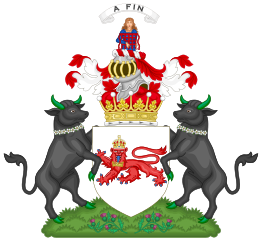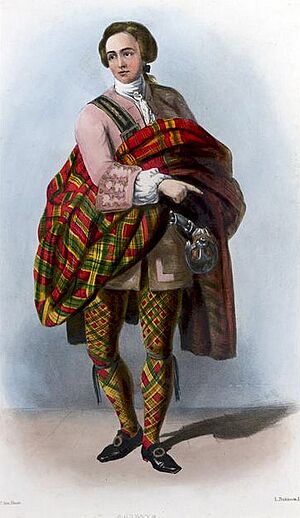Clan Ogilvy facts for kids
Quick facts for kids Clan Ogilvy/Ogilvie |
|||
|---|---|---|---|

Crest: A lady affrontee from the middle upwards Proper in Azure vestments richly attired, holding a portcullis Gules
|
|||
| Motto | "A Fin"—"To the end" | ||
| War cry | "To the end!" | ||
| Profile | |||
| Region | Highlands | ||
| District | Angus | ||
| Plant badge | Pentaglottis | ||
| Pipe music | The Bonnie Hoose of Airlie | ||
| Chief | |||
 |
|||
| David Ogilvy | |||
| 14th Earl of Airlie, Chief of Clan Ogilvy | |||
| Historic seat | Airlie Castle | ||
|
|||
|
|||
|
|||
|
|||
Clan Ogilvy or Clan Ogilvie is an old Scottish clan from the Angus area in the Highlands. The clan's story began in 1163 when Gillebride, the Earl of Angus, was given land by King William the Lion. Gillebride then gave some of these lands, called Ogilvy, to his son Gilbert.
Later, in 1491, King James IV made Sir James Ogilvy the first Lord Ogilvy of Airlie. A famous member of the clan was Saint John Ogilvie, a Scottish Jesuit who was executed for his faith in 1615. He is now a saint in the Roman Catholic Church.
In 1639, the 7th Lord Ogilvy of Airlie became the 1st Earl of Airlie. This was a reward from King Charles I for supporting the king during the Wars of the Three Kingdoms, a series of wars in Britain. Today, the leader of Clan Ogilvy is David Ogilvy, the 14th Earl of Airlie. His uncle, Angus Ogilvy, married Queen Elizabeth II's cousin, Princess Alexandra of Kent, connecting the clan to the royal family.
Contents
Clan History
Where the Clan Began
The lands of Ogilvy are in Angus. The name "Ogilvy" comes from an old language called Brittonic, and it means "high plain." Long ago, Angus was ruled by a "mormaer," which was a title for an ancient Celtic noble. These mormaers later became known as earls.
In 1163, Gillebride, who was the Earl of Angus, received a special grant of land from King William the Lion. He then gave parts of these lands, including Wester Powrie, Ogilvy, and Kyneithin, to his son, Gilbert. This is how the Ogilvy name became linked to the land.
Fighting for Scotland's Freedom
During the Wars of Scottish Independence, a man named Patrick de Ogilvy first promised loyalty to Edward I of England in 1296. However, his sons, Sir Patrick Ogilvy and Sir Robert de Ogilvy, were strong supporters of Robert the Bruce, who fought for Scotland's freedom.
Because of his loyalty, Sir Patrick Ogilvy was given land in Kettins. Robert de Ogilvy was known as one of Robert the Bruce's closest friends.
Important Sheriffs of Angus
From 1365, the Ogilvys became the Sheriffs of Angus, a position that was passed down through their family. A sheriff was like a local law enforcer and administrator. Walter Ogilvy became the Sheriff of Forfar (another name for Angus) after his uncle, Sir Malcolm Ramsay, passed away. In 1369, Walter also gained control of the lands of Cortachy.
In 1391, Sir Walter Ogilvy, as Sheriff of Angus, led Clan Ogilvy in a battle against Alexander Stewart, Earl of Buchan, who was also known as "the Wolf of Badenoch." This event is known as the Raid of Angus.
14th and 15th Century Events
Members of the Ogilvy clan fought in the Battle of Harlaw in 1411. Sir Patrick Ogilvy also led Scottish soldiers who fought alongside Joan of Arc against the English. He was given the title Viscomte d'Angus in France.
On January 24, 1445, Clan Ogilvy, with help from Clan Oliphant, Clan Seton, Clan Gordon, and Clan Forbes, fought in the Battle of Arbroath against the Master of Crawford and his Clan Lindsay.
In 1425, Sir Walter Ogilvy, a younger son of the Ogilvys of Wester Powrie, became the High Treasurer of Scotland. He was also sent as an ambassador to England in 1430. Four years later, he traveled with Princess Margaret for her marriage to the Dauphin, who was the future king of France. Sir Walter had many sons. One of them, another Walter, became the ancestor of the Earls of Seafield and Deskford. His oldest son, Sir John Ogilvy of Lintrathern, received the lands and Airlie Castle in 1459. In 1491, Sir John's son, Sir James Ogilvy of Airlie, was sent as an ambassador to Denmark.
16th Century Battles
James Ogilvy, the oldest son of the fourth Lord, was killed in the Battle of Pinkie Cleugh in 1547. This was a major battle between Scotland and England.
17th Century and the Civil War
In 1615, Saint John Ogilvie was executed in Glasgow. In 1639, the seventh Lord Ogilvy was given the title of Earl of Airlie. The Ogilvy family faced many challenges because they supported the Stuart kings. The Earl and his sons joined James Graham, 1st Marquis of Montrose to fight against the king's enemies.
The Earl fought bravely at the Battle of Kilsyth, where Montrose's side won. Sir Thomas Ogilvy, the Earl's second son, formed his own group of soldiers to fight for the king. Sadly, he was killed at the Battle of Inverlochy (1645), which was another victory for Montrose.
The Earl's oldest son, Lord Ogilvy, fought at the Battle of Philiphaugh in February 1645. In this battle, Montrose's forces were surprised by a strong group of Covenanter soldiers led by General David Leslie, Lord Newark. Montrose escaped, but Ogilvy was captured. Ogilvy was waiting to be executed in St Andrews Castle. However, his sister visited him and they swapped clothes. Ogilvy managed to escape without the guards noticing. He lived to see the Restoration, when the monarchy was brought back.
18th Century and Jacobite Risings
The Clan Ogilvy supported the Stuart family during the Jacobite rising of 1715. Lord Ogilvy was declared a rebel, but he was allowed to return home in 1725. However, his titles were not given back to him. When he died in 1730, his younger brother, John Ogilvy, began using the title Earl of Airlie.
During the Jacobite rising of 1745, John's son, David Ogilvy, gathered a group of soldiers, mostly Ogilvys, to fight for Prince Charles Edward Stuart. In 1746, this group fought at the Battle of Culloden. After their defeat at Culloden, Ogilvy escaped to France. There, he joined the French royal army and became a general. The title of Earl of Airlie was not officially restored until 1896 by an Act of Parliament, when it was confirmed for David Ogilvy, the sixth earl. Interestingly, another branch of the family, the Ogilvy Earl of Seafield, had supported the Acts of Union 1707, which joined Scotland and England.
The Clan Today
David Ogilvy, the 14th Earl of Airlie, is the current leader, or Chief, of Clan Ogilvy. His father, the 13th Earl, worked for Queen Elizabeth II as her Lord Chamberlain. The clan's connection to the royal family was also strengthened when Angus Ogilvy, the chief's uncle, married HRH Princess Alexandra of Kent.
Many people from the Ogilvy/Ogilvie family live all over the world today. You can find them in places like South Africa, Australia, Norway, Spain, Sweden, United States, Canada, New Zealand, Argentina, Mexico, and Cyprus.
Clan Castles
- Airlie Castle, also known as Errolly Castle, is about four miles northeast of Alyth in Angus. The current building is a large house built in 1793, but it includes parts of an older castle. The original castle was built in 1432 by the Ogilvys. It was protected by a deep ditch between two rivers.
- Cortachy Castle, about three miles north of Kirriemuir, Angus, is a castle with a courtyard that dates back to the 1400s. It became part of the Ogilvy family's lands in 1473. Charles II of England stayed a night at the castle in 1650 in a room now called the 'King's Room'. The next year, the castle was attacked and damaged by Oliver Cromwell's forces.
- Auchindoun Castle was owned by the Ogilvys from 1482 until 1535, when it passed to the Clan Gordon.
See also
- Ogilvie (name)
- Ogilvy (name)
- Scottish clan




